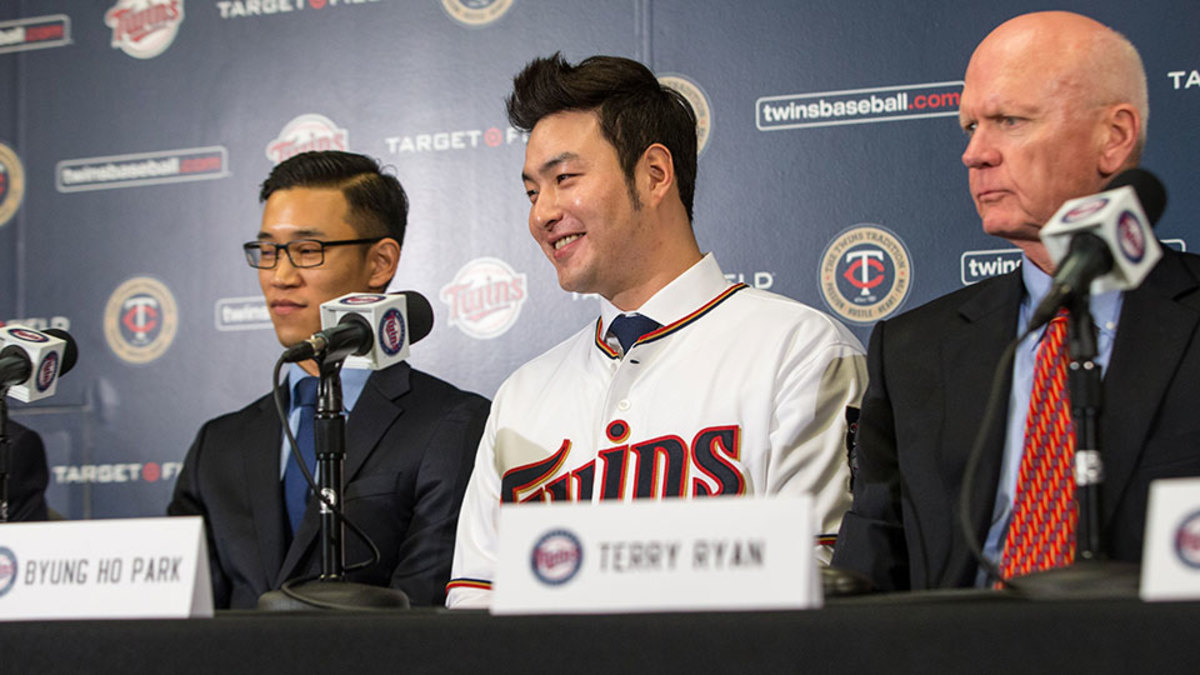Winter Report Card: Twins have quiet off-season, but with good reason
With less than four weeks before pitchers and catchers report to spring training, we're checking in to see how each team has fared thus far this off-season while acknowledging that there's still time for that evaluation to change. Teams will be presented in reverse order of finish from 2015. Now up: the Minnesota Twins. You can find all previously published Winter Report Cards here.
2015 Results
83–79 (.512), second place in American League Central (Hot Stove Preview)
Key Departures
RHP Blaine Boyer*, LHP Neal Cotts*, LHP Brian Duensing*, CF Aaron Hicks, RF Torii Hunter, RHP Mike Pelfrey, OF Shane Robinson
Key Arrivals
C John Ryan Murphy, 1B Byung-ho Park
(*free agent, still unsigned)
Off-season In Review
The big question for the Twins coming into this winter was how they were going to make room for Miguel Sano to play the field in his age-23 season. The assumption was that they would trade incumbent third baseman Trevor Plouffe, who is heading into his age-30 season, has two years of team control remaining and is getting expensive via arbitration. Instead, Minnesota decided to keep Plouffe (who signed for $7.25 million for the coming year) and added Korean first baseman Byung-ho Park via a four-year, $12 million deal plus a $12.85 million posting fee.
Winter Report Card: Nationals cope well with big free-agent losses
With incumbent first baseman Joe Mauer still owed $69 million over the next three years, keeping Plouffe and signing the 29-year-old Park—who hit 105 home runs for the KBO's Nexen Heroes over the last two seasons—eliminated designated hitter and both infield corners as options for Sano. Instead, the Twins announced that the strong-armed sophomore would be their new rightfielder, replacing the retired Torii Hunter.
That certainly has the potential to maximize the potency of the Twins' lineup, which would also benefit from Byron Buxton living up to his hype in centerfield and both Buxton and Sano spending full seasons in the majors. But Sano has never played the outfield as a professional despite signing with the Twins at the age of 16. Though a competent third baseman, Sano doesn’t necessarily profile as a natural outfielder, particularly given his listed size of 6’4” and 260 pounds. After watching the more athletic Hanley Ramirez’s excruciating attempt to play leftfield for the Red Sox last year, it’s difficult to muster all that much optimism about Sano making a similar transition.
Winter Report Card: Orioles still have holes to fill but few options left
That uncertainty adds to the sense that the Twins still see themselves as a team in transition. When previewing the team's off-season back in November, I wrote that “the big question Minnesota has to ask itself ... is whether or not it wants to make a big push now or give its kids another year to develop.” Given their relative lack of activity this winter, the Twins appear to have chosen the latter path. Other than signing Park, the only other notable transaction they made was the early-November trade that sent centerfielder Aaron Hicks to the Yankees for catcher John Ryan Murphy, who will be 25 in May and arrives with five remaining years of team control (one more than the 26-year-old Hicks). Murphy has the potential to provide a modest offensive upgrade at catcher—something that was on the Twins’ list of off-season needs—but he’s not a lock to have a career as a major league regular. Instead, he’s yet another young player to be evaluated in the coming season before Minnesota decides how to move forward.
Unfinished Business:Evaluating what they have
The Twins were wise not to overreact to the big step forward they took last season. They could have sunk resources into trying to upgrade their starting rotation or bullpen, but given the big contracts they handed out to starters over the last two years and the talent still bubbling up through the minors (primarily righties Tyler Duffey and Jose Berrios), taking a wait-and-see approach there makes sense. What will have as much impact—if not more—on the Twins' future is seeing how the team's young nucleus develops in 2016. Sano’s transition to the outfield and the adjustments made by Buxton, Berrios and Park to the majors are both critically important, as are the abilities of 24-year-old outfielder Eddie Rosario, Duffey and Murphy to repeat or improve upon their rookie seasons. Minnesota also must sort through the young arms in the bullpen, and perhaps even give slugger Kennys Vargas and shortstop Danny Santana (both just 25 years old) a chance to reestablish their value after down 2015 seasons.
Preliminary Grade: B+
The Twins were as inactive as the Rays and the Indians this winter, but that was an appropriate approach. Minnesota’s future is its young, homegrown talent; rushing it or trading it in an ill-timed "win-now" off-season could have derailed the team’s return to contention. I’m pessimistic about Sano’s transition to the outfield, but if it doesn’t work, the Twins still have time to trade Plouffe and move Sano to his natural position. Murphy is nothing special, but he’s a young cost-controlled player who addresses what was arguably the team’s biggest need this winter. Park is unlikely to challenge for the home run title, but he should be a productive bat and will cost Minnesota only slightly more than $6 million per year even with the posting fee factored in, and he should easily out-produce what the team got from Hunter last year. The Twins didn’t do much, but I fully expect them to be a better team in 2016 than they were in '15.



































